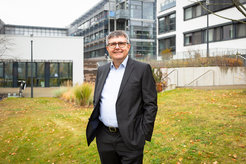Potsdam participation in international research collaboration
Synergies at top level
On February 3, the virtual inauguration of the first Max Planck Center on the Australian continent will take place. At the Max Planck Queensland Center (MPQC), project teams will explore biological materials known as extracellular matrices. "With this, we are putting a new field on the research map, focusing not only on biomedical applications, but also on technical ones, such as in architecture," says Center co-director Peter Fratzl.

Extracellular matrices (ECMs) are found in almost all living organisms. They surround the biological cells, but are themselves inanimate and perform a variety of tasks. For example, they signal to cells which tissue they belong to, respond to changing environmental conditions, and store information that stimulates or inhibits cell growth.
The Max Planck Queensland Center (MPQC) is a collaboration between the Max Planck Institutes of Colloids and Interfaces (Potsdam) and of Intelligent Systems (Stuttgart) and the Queensland University of Technology in Brisbane. The Center started its work on January 1, 2022, and will now collaborate on a total of seven projects for five years.
"In one of the projects with Potsdam participation, we want to better understand in which biophysical and biochemical characteristics the extracellular matrices of healthy and diseased tissue differ," says Peter Fratzl, director at the Max Planck Institute of Colloids and Interfaces (MPIKG). This is because extracellular matrices are also involved in tumor growth and the spread of metastases, among other things. Another project is investigating the material properties of biofilms in order to adapt them to technical requirements with the help of microorganisms. To this end, the polysaccharides of extracellular matrices of biofilms are also generated synthetically. Subsequently, it will be investigated how the colonization of certain bacteria as well as the properties of the biofilms can be controlled and optimized. In the future, these materials could be used in architecture, for example, by positively influencing the indoor climate.
“The opening of the Centre in Queensland shows, what material the team at the Max Planck Institute of Colloids and Interfaces and their Australian partners are made of: They are outstanding researchers who seek versatile discourse, and break down boundaries in the process: National boundaries, continental boundaries, and, above all, the boundaries of established knowledge. Down Under and in Brandenburg, joint research is being conducted on key issues of the future: biomaterials and green energy generation. Our ‘Potsdam Science Park’ really is as international as its name suggests. Global science is establishing itself in Brandenburg – and Brandenburg is establishing itself in the world”, says Dr. Manja Schüle, Minister of Science and Research in Brandenburg.
Background Max Planck Center
There are a total of 25 Max Planck Centers worldwide, which were founded as a central element of the internationalization strategy of the Max Planck Society. As virtual centers of excellence, they flexibly combine knowledge and methods. Interdisciplinary researchers cooperate with first-class international partners to gain insights in pioneering research areas.
Link to registration: https://bit.ly/34pgQDv












